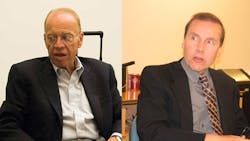MH&L Editorial Advisory Board Roundtable--Part 6: The Internet of Things and Other Future Destinations
The sixth and final installment in MH&L's Roundtable Series focuses on where we're heading with our technology and talent. If you're coming to this last section first, make sure to catch the previous installments of this series so you can appreciate what got us here:
MH&L Editorial Advisory Board Roundtable--Part 1: Competing in a Global Marketplace,
MH&L Editorial Advisory Board Roundtable--Part 2: The Infrastructure Capacity Crunch,
MH&L Editorial Advisory Board Roundtable--Part 3: Technology Challenges,
MH&L Editorial Advisory Board Roundtable--Part 4: Channel Changes,
MH&L Editorial Advisory Board Roundtable--Part 5: Talent Development is Your Job
ANDEL: It seems that if the Uber model is going to work in logistics we'll need logistics networks that will better serve those different environments. Ron, how do you see this working on the transportation side?
GIUNTINI: Say I have an Uber car. I am available to provide you with a service to go from point A to point B in a particular location, and Uber manages this exchange. They match buyers and sellers. But I don't think that's going to be the model ultimately. I think their model will really add value in parcel delivery. We have always talked about that last mile. Think about 230 million vehicles in the United States, and the average vehicle is used about one hour a day. The drivers would be certified. It would be like a commodities market, where you would bid, and the parcels could be delivered at any rate, depending on the distance, at very reasonable prices
TOMPKINS: The impact will totally change traffic flows. And the reality is UPS and FedEx are in the wrong business because they are in the nationwide delivery of parcels. There is no nationwide delivery of parcel activity anymore because the 3PLs and the retailers and the consumer products companies, who are becoming retailers, all need to get local.
ANDEL: Ann, representing a 3PL, where do you and your competitors need to go in this environment?
CHRISTOPHER: Shared services are everywhere. You see it in our multi-client facilities, where they are sharing equipment. Even if we are in a dedicated facility, we may want to work out an arrangement with the client saying, you know what? If there is dead space here, we will try to market and bring in an approved client. But where product drop-off is concerned, I can't help but think from my legal mind that there are a lot of things that still need to be thought through. For example, on the cars, who is doing the maintenance and securing the insurance? What if there is an accident? Who is primarily responsible?
GIUNTINI: I agree. I think the infrastructure has to be built--on the legal side, also. But the point is that the solution is desired so the infrastructure will catch up to it. Right now we are sort of breaking a few eggs.
ANDEL: Equally challenging in terms of logistics networking at the front end will be setting up the Internet of Things [IoT], where technology-equipped appliances may be talking to each other and initiating orders that go through the supply chain on the consumers' behalf.
Listen to John Hill's take on the Internet of Things:
HILL: These developments are happening very quickly, both here and overseas. In fact, in Europe, it is better sponsored and better focused than it is here in the U.S. Cisco is putting millions of dollars into development of machine-to-machine communications networks and that's going to funnel into demand planning and inventory optimization. Those who are pushing forward with the IOT concept are very well aware of the challenges addressed in MHI's road map, including urbanization. Whether or not they are talking to each other is a question I can't answer today.
Watch our interview with industrial trainer Jim Shephard on shaping today's and tomorrow's talent.
About the Author
Tom Andel
Editor-in-Chief
Tom Andel is an award-winning editorial content creator and manager with more than 35 years of industry experience. His writing spans several industrial disciplines, including power transmission, industrial controls, material handling & logistics, and supply chain management.
